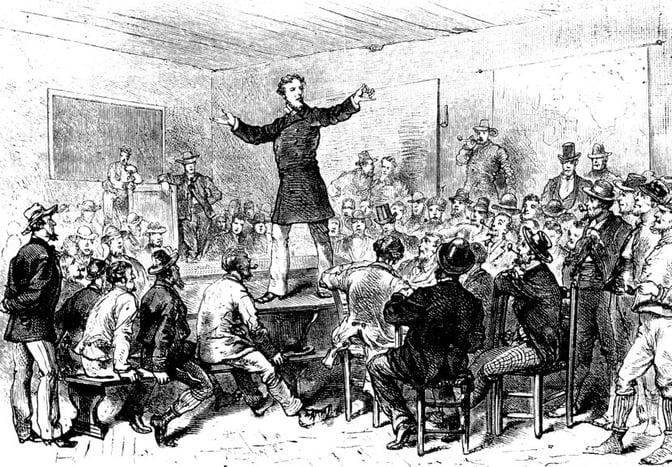
Every time you speak, you need to take listeners on a journey. Here's how to engage audiences so they enjoy every step along the way.
You want to be successful when you speak in public, right? Influencing audiences—making people's lives better in some way—is what you're aiming for.
Yet it seems to me that's not enough of a goal if you're really looking to make a splash. Don't you also want to engage listeners totally so they love your presentations?
Whenever you speak in public, you're performing two tasks simultaneously: you're telling a story, and taking your audience on an exciting journey. These tasks aren't mutually exclusive, but depend on each other.
Like Scheherazade in One Thousand and One Nights* staving off her execution night after night, your job is to tell a tale with passion and commitment. And like the king in that folk tale, your audience shouldn't be able to get enough of your storytelling prowess and the magical place you're taking them.
To perform at that level, you need to be 100% attentive to the task at hand. That's where maximum public speaking focus comes in. Discover my theater-based techniques for commanding a stage and displaying total stage presence and confidence. Download my essential cheat sheet, "10 Ways to Stay Fully Focused when Speaking."
Can You Build a Narrative?
What I'm talking about here is an aspect of storytelling you never hear about. Of course, every time you speak you're telling a story of some kind. It may be as groundbreaking as how your company will transform your industry, or as everyday as why your division needs to reign in operating expenses. Whatever information you're imparting, you'll ease your task by using a narrative structure involving people and why your topic will make a difference in their lives.
The way to succeed, then, is to think in terms of that narrative rather than simply delivering data. "How can I connect this information to the people listening who will benefit?" is the question that will point you to the storytelling path.
Once you've built the wings of your story, it's time to fly. That's where public speaking performance comes in. But this is my whole point here: Again and again in my speech coaching practice, I help clients with an urgent need: to allow their speech to make sense and be easy for audiences to follow. Here are three approaches I give them, that will also help you to foster maximum engagement and comprehension in your listeners.

1. Know How the Parts of Your Speech Fit Together
The worst thing any speaker can do to an audience is present them with a blob: an amorphous collection of information without shape and seemingly lacking purpose. Yet speakers do it all the time. Many of us disguise the nature of the blob monster by creating bullet points. That appears to organize everything and lend an easy-to-follow structure to the talk.
Yet there is no real organizing principle there, just a linear collection of bulleted phrases. To accomplish your purpose, you have to think strategically. And that means shaping your talk.
The analogy I use is a string of pearls: each part of your speech is a thing of beauty in itself—and together, those parts form the whole, a magnificent necklace. No speech can be a collection of data points delivered to end-users as though on a conveyor belt.
So, you decide: which parts of your speech have greater weight and therefore need more emphasis? Where does the climax come? Should you deliver your message first so it has maximum impact, or reveal it later on when your audience is better prepared to receive it? Should the crisis, or the background leading up to the event come first? You get the idea.

2. Share the Logic of Your Story with the Audience
While we may try hard to include all the information an audience needs as food for thought, we often leave a key ingredient out of the recipe: logic. Remember: you know how the elements of your speech fit together and why you've arranged your main points this way. But the audience won't have a clue unless you take the time to explain it.
Let's say you're giving an inspirational keynote to a young audience on the true definition of success. You want to share some self-awareness you developed while working on a major project when you yourself were young. You have three main sections: (1) your awkwardness growing up, (2) the decisions you made in college and their consequences, and (3) the self-growth that flowed from both these earlier times of your life when you began working.
Now imagine you begin with some embarrassing incidents that happened at school (one of which, surprisingly, you experienced again recently at the office). Some of what shaped you took place at an internship you worked at between your freshman and sophomore year of college. That's when you made some decisions, and began to learn about consequences. Anyway, your college career as a whole was an overall learning experience for you. You had an idea (from those awkward years in school) that you had to reach out and connect with people more. And that's more true than ever, now that you're on the creative team at your third start-up!
If there's a logical progression to that speech in your own mind, your audience won't figure it out if that's the way you proceed! A great way to provide the logical framework any audience needs is to tell them, up front, the specific areas you're going to discuss. Give them a preview of the journey you're going to take together. And clue them in on the treasure at road's end.

3. Performing Your Speech: Working the Transitions
Will you forgive this actor if he says that performance is one of the easiest ways to keep an audience with you? Let's say that per the above, you've given some thought to the shape of your speech and its logical framework. Now you can use two-and-a-half performance techniques to make your speech easier to follow and more enjoyable.
I'm only partly joking here. That's because two of these techniques are essential, and the third is icing on the cake. Do these simple things when you speak, and your audience will be able to follow you more easily, and also retain what you said.
I'm speaking here of the transitions in your speech. Each time you move from the main point you've just been discussing to the next one, you need to need to allow your audience to process the change. That's important, because it says to them: "That's the end of that point. Here's something new and exciting for you." Every audience member appreciates taking a mental breath and getting ready for the next interesting thing. Contrast that with the drumbeat of information that sounds exactly like everything that came before.
How do you help your audience hit the mental "refresh" button? Pause, then do something different with your voice. It really doesn't matter what: raise or lower your pitch, change your vocal quality, vary the pace, etc. The two elements—pause and vocal change—alert listeners to pay attention anew. (They'll also retain the individual points more strongly.) And the bonus component? Move. Just a step or two may be enough. It's visual evidence of the refreshing change in your speech.
* King Shahryār, who rules in the Middle or Far East, marries only virgins, and executes them the following morning before they can be unfaithful. When all the available woman are gone, Scheherazade, the daughter of the king's adviser offers herself. On their wedding night, she tells her new husband a fasincating tale but doesn't end it. The king delays her execution until he can hear the conclusion. The following morning his wife tells him the end of the story . . . and immediately begins a new intriguing tale. This goes on for 1,001 nights. (Wikipedia: "One Thousand and One Nights".)
You should follow me on Twitter here.



